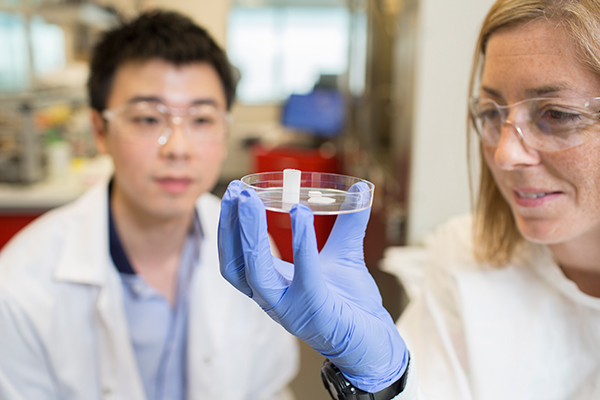January 5, 2015
Body builders to transform medicine with new 3D printing course
The future leaders in regenerative medicine are being encouraged to apply to study a new Master's Degree where students will use 3D printing technology to regrow human tissue.

The University of Wollongong-headquartered ARC Centre of Excellence for Electormaterials Science (ACES) has joined forces with three leading research universities to offer the world's first Master's Degree in BioFabrication (Master of Philosophy in BioFabrication) to award graduates qualifications inAustralia and Europe.
Biofabrication describes a process of regrowing human tissue using 3D printing techniques, and will enable health professionals to offer patients improved, personalised treatments in the future.
All world Leaders within the biofabrication field of research, the four universities offering the course are: UOW and Queensland University of Technology in Australia, and the University Medical Center Utrecht in the Netherlands and the University of Wurzburg in Germany.
ACES Director Professor Gordon Wallace said the Master's degree would provide participants with highly sought-after, internationally recognised skills in biofabrication.
"Graduates will have an international network, a track-record of collaboration with the world's leading bionics, fabrication and bio-ethics experts and an appreciation of all the processes involved in taking an idea through to commercial reality," he said.
Current research is focused on regrowing nerve and tissue damaged by disease or injury, which could offer new treatments for breast cancer patients following mastectomy and rehabilitating people who suffer spinal chord injury.
This new field of medicine employs 3D printing techniques, which deposit and fuse materials layer-by-layer to form a pre-designed shape. These custom-made shapes made from suitably biocompatible materials can be implanted into the body an act as a support on which new tissue can grow.
Growth factors or the patient’s own cells are seeded in the scaffold to help spur the body’s healing process. After the new tissue has formed the printed structure is designed to dissolve in the bloodstream.
Although a 3D printed fully functioning organ is still some way off, biofabrication has already successfully being used to repair broken and missing bone.
Each participating university has a track record in key areas of biofabrication, including polymer chemistry, cell biology, clinical implants and the process of fabrication.
“The key strength ACES brings to the partnership is our expertise in providing end-to-end biofabrication solutions. This means we have the capability to help researchers take their idea from a concept, right through to a product that can be used to help patients,” Professor Wallace said.
For example, ACES has expertise in forming printable bio-inks, stem cell biology, and developing custom bioprinting and 3D printing hardware.
This expertise has led to many innovations in materials and delivery: formulations that allow living cells to be delivered as part of the 3D printing process and tools such as the BioPen to deliver the cell material.
The Masters degree, now open for applications, will admit 10 students per participating university to the degree. Students will spend the majority of time with their host organisation, and between nine to 12 months with one of the participating international counterparts.
Professor Wallace said biofabrication was a multidisciplinary area of research that required an understanding of chemistry, physics, biology, medicine, robotics and computer science. He encouraged graduates in these fields to apply for the Masters degree.
The Masters degree in Biofabrication for Future Manufacturing is supported by the Australian Government and the European Union.
More: Expressions of interested can be lodged at electromaterials.edu.au